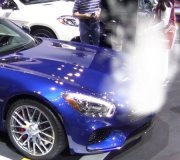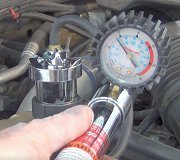Welcome back:
It's a big job. I hope you are sitting. Here are the directions. First will be the cylinder head removal and then the timing. All attached pics correlate with the directions.
___________________________________
1996 Chrysler Sebring L4-2.0L DOHC
Removal and Installation
Vehicle Engine, Cooling and Exhaust Engine Cylinder Head Assembly Service and Repair Procedures Removal and Installation
REMOVAL AND INSTALLATION
1. Disconnect battery ground cable.
2. Relieve fuel system pressure as follows:
a. Disconnect fuel pump harness connector at fuel tank.
B. Start engine and let it run until it stalls, then turn ignition switch to off.
C. Disconnect battery ground cable.
D. Reconnect fuel pump harness connector.
3. Drain engine coolant, then drain crankcase.
4. Disconnect electrical connectors from A/C compressor clutch, power steering pump switch, oxygen sensor, engine coolant temperature switch and sensor, MAP sensor and intake air temperature sensor.
5. Disconnect accelerator cable.
6. Disconnect TPS, IAC motor and injector harness electrical connectors.
7. Disconnect ignition coil, camshaft position sensor and EGR solenoid electrical connectors.
8. Disconnect heater hose, upper radiator hose, overflow tube and water hose connection.
NOTE: Mark relationship between radiator hose and clamp for installation reference.
9. Disconnect fuel high pressure and return hoses.
10. Disconnect purge air hose.
11. Disconnect power brake booster vacuum hose connection.
12. Remove intake manifold stay.
13. Remove intake and exhaust camshafts as described under Engine/Camshaft, Engine/Service and Repair/Camshaft Replacement.
14. Disconnect exhaust pipe from exhaust manifold.
15. Remove cylinder head attaching bolts, then remove cylinder head and gasket. After cylinder head removal, remove intake and exhaust manifold as necessary.
Fig. 28 Cylinder Head Bolt Tightening Sequence
See pic 1
16. Reverse procedure to install, noting the following:
a. Prior to installation, inspect cylinder head bolts for stretching by placing a straightedge against bolt threads. If all threads do not contact straightedge, replace bolt.
B. Clean bolt threads and lubricate with clean engine oil.
Without Multi Layer Steel Head Gasket
c. Tighten cylinder head bolts in sequence shown in Fig.28.
Torque bolts 1 through 6 to 25 ft.-Lbs, and bolts 7 through 10 to 20 ft.-Lbs.
Next, torque bolts 1 through 6 to 50 ft.-Lbs. And bolts 7 through 10 to 20 ft. Lbs.
Again, torque bolts 1 through 6 to 50 ft.-Lbs, then bolts 7 through 10 to 20 ft.-Lbs.
Finally, tighten all bolts an additional 90°.
With Multi Layer Steel Head Gasket
Note: The four short bolts are placed in the corners.
Step 1
Torque all center bolts to 34 Nm (25 Ft Lbs), Torque the 4 corner bolt to 27 Nm (20 Ft Lbs)
Step 2
Torque all center bolts to 68 Nm (50 Ft Lbs), Torque the four corner bolts to 47 Nm (35 Ft Lbs),
Step 3
Re-torque all center bolts to 68 Nm (50 Ft Lbs), Re-torque the 4 corner bolts to 47 Nm (35 Ft Lbs).
Step 4
Tighten all bolts in the Specified sequence an additional 90° (1/4 turn).
D. When installing radiator hoses, align marks on clamps and respective hoses
CAUTION: When the following parts are replaced with new ones, be sure to use the scan tool to synchronize the camshaft position sensor with the crankshaft position sensor again or disconnect the negative battery cable for 10 seconds or more:
- Camshaft
- Camshaft Sprocket
- Timing Belt
- Tensioner
- Cylinder Head
- Head Gasket
- Crankshaft Sprocket
- Crankshaft
- Cylinder Block, etc.
_________________________________________________________________________________________
Now for the real headache. If you do this, I would recommend replacing the timing belt and accessories at the same time.
_________________________________________________________________________________________
Timing Belt Removal and Installation
Vehicle Engine, Cooling and Exhaust Engine Timing Components Timing Belt Service and Repair Procedures Timing Belt Removal and Installation
TIMING BELT REMOVAL AND INSTALLATION
NOTE:
With the timing belt removed, avoid turning the camshaft or crankshaft. If movement is required, exercise extreme caution to avoid valve damage caused by piston contact.
REMOVAL
Fig. 54 Timing Belt Replacement
pic 2
Remove timing belt in numbered sequence as shown, noting the following:
Fig. 55 Crankshaft Pulley Removal
pic 3
1. Remove crankshaft pulley as shown.
2. Remove power steering pump from the bracket with hose attached and secure out of the way.
3. Place a suitable jack and wood block beneath engine and slightly raise engine to remove engine mount bracket.
Pic 4
4. Align timing marks on camshaft intake and exhaust sprockets before loosening belt tensioner to remove timing belt, Ensure camshaft and crankshaft are not rotated after belt is removed.
5. When belt tensioner is removed, it is necessary to compress the plunger into the tensioner body:
Fig. 57 Timing Belt Tensioner Compression
pic 5
a. Place tensioner in a suitable vise and slowly compress the plunger.
B. Index tensioner in vise the same way it is installed on engine to ensure proper pin orientation when installed on engine.
C. When plunger is compressed into tensioner body, install a pin through body and plunger to retain plunger in place until tensioner is installed.
CAUTION:
Do not loosen, remove or tighten tensioner pivot bolt. If this bolt is disturbed, entire pivot bracket assembly must be replaced.
INSTALLATION
Reverse removal procedure to install noting:
Fig. 59 Crankshaft Sprocket Alignment
pic 6
1. Set the crankshaft sprocket to TDC by aligning the sprocket with the arrow on the oil pump housing.
2. Using a suitable wrench, move crankshaft to 1/2 notch before TDC.
Pic 7
3. Set the camshaft timing marks by aligning the notches on sprockets.
Fig. 60 Timing Belt Installation
pic 8
4. Install timing belt, starting at crankshaft, around water pump sprocket, idler pulley, camshaft pulleys and tensioner pulley.
5. Move crankshaft sprocket to TDC to take up belt slack.
6. Install belt tensioner to engine block but do not tighten fasteners.
7. Using a suitable torque wrench on the tensioner pulley, torque to 28 ft.-Lbs.
Fig. 61 Timing Belt Adjustment
pic 9
8. With torque being applied to the tensioner pulley, move the tensioner up against the tensioner pulley bracket and torque fasteners to 23 ft.-Lbs.
9. Pull the tensioner plunger pin. Pretension is proper when pin can be easily removed or installed.
10. Rotate crankshaft two revolutions and inspect alignment of timing marks. If not proper, repeat procedure.
_________________________________________
If you decide to do this, let me know. Also, feel free to ask questions if you have them. I was also wondering how much coolant was coming out and if it started while the engine was still cold?
Let me know,
Take care,
Joe
Images (Click to make bigger)
Saturday, September 26th, 2020 AT 10:18 AM
(Merged)












